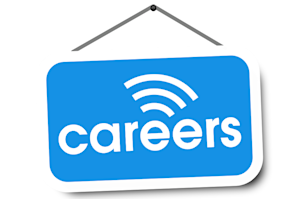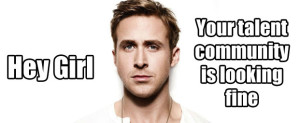I communicate for a living. I am communicating with you right now. And now. And now!
But still, every single time I visit my doctor for a check-up, all of my communication skills go right out the window. I can barely manage to convey my age, let alone what ails me.
I have always had the gift of the gab. It's what I credit for the success of my previous career in sales. I can pretty much talk to anyone about anything. Unless, of course, that person is wearing a white coat and a stethoscope.
This is most likely due to the fact that doctors have always made me nervous. No matter how kind their eyes, or soft their bedside manner, I fear their authority and tongue depressors as much now as I did when I was a kid.
So, whenever I have to make a trip to the doctors office, my husband supplies me with both a pep talk and a list of talking points.
What does this have to do with social recruiting you ask?!
Well, social media and technology in general still makes a lot of people nervous (myself included, if I'm being completely honest). These nerves can make communicating difficult, and social recruiting doesn't work without good communication. You can't attract candidates through Facebook and Twitter without engaging with them.
Luckily, there are quite a few ways to make communicating via social networks easy. In fact, once you have a good formula down, engaging with candidates is a breeze!
Let's start with the basics. These concepts apply to pretty much any social network out there, even the image-based ones!
Make your posts relatable
People engage with posts they can relate to. That's why pet pictures, food pictures, and articles about procrastination get so many shares. These are concepts most people cant relate to. I would highly advise sticking with these kinds of posts and avoiding Tweeting about how you're drinking Cristal on a yacht, unless you are looking to recruit Mr. Howell from Gilligan's Island!
Post funny (inoffensive) comics on your Facebook Page, pics of staff parties on Instagram, and Tweet a recent article you thought was awesome.
Check out this article for more tips on how to engage candidates through social media.
KISS it
You don't have to overcomplicate things, in fact, it just confuses people! Respond with clear, simple language, and keep it short. Don't assume people know what anagrams like ROI, or KISS mean. Oh wait... (It stands for Keep It Simple Silly)
But, even if your writing isn't perfectly concise, just making sure that you respond to questions and comments in a timely and friendly manner is all that really matters.
Make like Goldilocks
Find that bowl of porridge that is neither too hot, nor too cold. I love this analogy. Mostly because I love breakfast. But also because it's a reminder of how important it is to experiment a bit, find your sweet spot, and then go with it.
Try using a "Call to Action" such as "If you're an awesome graphic designer, then Like this job!" or asking more direct questions. Experiment with different voices, wording, and post lengths. This will give you a feel for how your community responds to different communication styles, and a better understanding of much you need to interact.
Check out this post for more on how to find your social media sweet spot.
Be chatty
Unless you are communicating with a group of "experts" or other professionals in a similar field, it's important to maintain a casual tone.
Communicating via social networks is different from communicating via email. It's more casual, relaxed, and conversational. I'm not suggesting that you interact with potential candidates or customers the way you would with your pals at a UFC fight night, but remember that communicating on sites like Facebook is a conversation — not a monologue.
Hopefully these tips will have you chatting candidates up all over the internet or maybe even in real-life (God forbid)! Just promise you won't use any of them for dating, as advice columnist Ask E. Jean and I have a strict non-competition pact, and I don't want to get on her bad side!
Happy recruiting!
Read More







